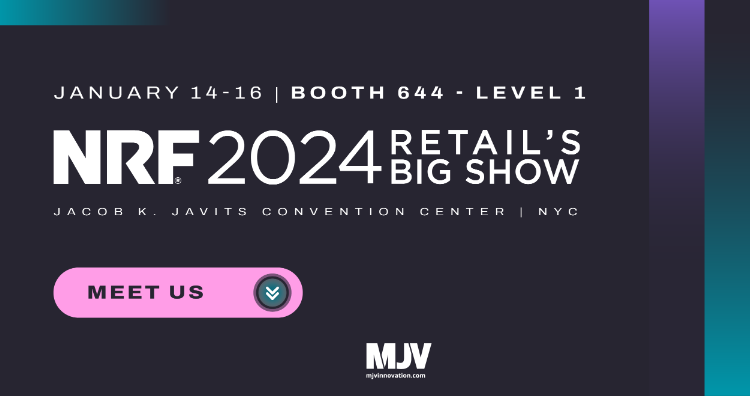7 Takeaways from NRF 2024: Retail’s Big Show
With the world’s largest retail event behind us, it’s time to go over our key takeaways from NRF 2024.
Read on to learn a little more about the event, our participation, and the hottest topics from Retail’s Big Show!
About NRF 2024: The Largest Retail Event In The World
NRF 2024: Retail’s Big Show is the world’s leading annual retail event, with around 40,000 on-site retail specialists from almost 100 countries. Its members include department stores, catalogs, independent retailers, restaurants, grocery stores, multi-level marketing companies, and vendors.
The National Retail Federation represents the largest private-sector industry in the United States containing over 3.8 million retail establishments, supporting more than 52 million employees, and contributing $3.9 trillion to the United States’ annual GDP.
Just take a look at some of the statistics for NRF 2024, and you’ll see that it’s no boast when we say “the world’s leading annual retail event.”

The event took place at the Jacob K. Javits Convention Center in New York City from January 14-16 and was an incredible experience for all involved.
MJV @ NRF 2024
For the second consecutive year, MJV was in NYC exhibiting and sponsoring the retail store tours.
MJV’s retail know-how
With 25 years of experience operating in the retail sector, MJV has been there and back again. In particular, we’ve seen the industry transform in the digital age. With our expertise in putting together more than 500 retail & CPG projects, we are confident that we can unlock the answer no matter what your retail challenge is. We pride ourselves on delivering cutting-edge retail and CPG solutions.

Sponsorship
But that’s not all; we’ve also teamed up with NRF to sponsor one of their tours.
The Big Show Official SoHo Tour, where participants visited innovative retail outlets to experience the latest industry trends.
Phygital is The New Mainstream
At NRF 2024: Retail’s Big Show, the industry geared up to showcase its commitment to embracing innovation and addressing emerging challenges.
The retail landscape is on the brink of a transformative shift, as the convergence of physical and digital experiences is poised to become the new norm. Termed “Phygital,” this integration is set to reshape consumer interactions, supply chains, and operational strategies.
This phenomenon is nothing new, but it’s been gaining more and more traction over the last few years and is set to take off in 2024: In-person viewing combined with home delivery, touchscreens that provide shoppers with useful information, and even Augmented Reality in stores are just a few of the innovations that we can expect from this growing trend.
But that’s just the tip of the iceberg. NRF 2024 provided retailers with many more insights into the future of retail. Let’s start by taking a look at some of the drivers of change that will be shaping the upcoming year.
7 Takeaways From NRF 2024
Changes in consumer behaviors, societal trends, and technological advancements are expected to reshape consumer packaged goods (CPG), fast-moving consumer goods (FMCG), e-commerce, and retail sectors.
Alongside what will be pushing retail forward and what will be blocking its path, there are several trends that we will undoubtedly see littering the path towards the future. These trends are going to play a big role in how companies tackle challenges and implement innovations, and took center stage at NRF 2024.
In this article, we’ll leave you with the top seven takeaways that were front and center at Retail’s Big Show.
1. Artificial Intelligence
The era of hyper-personalization, driven by AI and data analytics, is anticipated to take center stage, leading to tailored experiences for individual consumers. This is also a trend seen on the consumer side of things, with customers demanding more personalization in their shopping experiences.

Artificial Intelligence is expected to play a pivotal role in several strands. One of them is. Hyper-personalization. With customers demanding more personalization in their shopping experiences, organizations are investing in AI to drive hyper-personalized shopping experiences, utilizing generative technologies to understand and cater to individual preferences.
There’s an emerging strand that is poised to strongly rely on AI—the financial services operations’ fraud detection and prevention.
We’ve actually recently written up a case study about an AI-operated fraud detection project that we recently completed for a client. It’s just one of the many ways artificial intelligence is changing the game. You can read it here.

2. Retail Forecasting
Still, on AI, there is a subtrend that stands out, which refers to the use of AI to improve anything related to retail forecasting.
As AI becomes more sophisticated, its ability to predict is going to change the way that retailers look at issues—from reactive to proactive. The goal will be to preemptively tackle problems and seize opportunities before they appear.
The ability to use consumer data from previous months or even years to predict future demand and market movement is already benign used by retailers today, but the real insight here is how this trend will grow over the next year.
AI can provide significant optimization to balance and manage demand and supply. As important as knowing how to use AI is redefining processes to guarantee the feasibility of the tools alongside your management systems.
3. In-Store Experience
Physical stores are expected to make a comeback, emphasizing immersive in-store experiences that go beyond traditional shopping. It’s gotten to the point where even companies that have gone bankrupt are using brick-and-mortar to make their comeback (think Toys ‘R’ Us).

Analysts who saw the pandemic as the end of all things physical are now backpedaling in order to make sense of the rise of in-person shopping. And that comes down to one possibility in our eyes: the rise of shoppertainment.
More and more consumers are looking to physical stores to provide them with more than just products they can get online, but actual immersive experiences. And with the way that VR, AR, and Mixed Reality are developing, it’s looking like the phygital experience is going to get a major update over the next few years.

4. Retail Theft
Retail theft is spreading across the US like wildfire. It’s even become increasingly common to see some franchises shut down because of it. Some companies are even taking unpopular measures to contain and decentivise theft, such as putting body cams on store security officers.
The problem with this? It absolutely destroys the purchasing experience, and prevents other trends, such as self-check-out or walk-out stores, from moving forward.
Innovations like checkout-free stores are poised to redefine the retail transaction process for instance. This has been exacerbated by our quick shift to touchless technology. AI will also play a big role in the feasibility and adoption of this technology, but the sudden boom in retail theft has created a barrier to this trend really taking off.
Self-checkout has already taken a hit in many major store chains, and Amazon has recently closed several of its cashier-less stores in the UK. In order to overcome this, stores are going to have to implement innovative security measures like facial recognition to take retail theft head-on before new check-out technology can really evolve.
5. Embedded Finance
Will we be able to differentiate between a bank and a retailer by 2050? Apple seems to think that the answer to that question is “no.”
More and more retailers are offering financial service solutions to their customers, and it’s only a matter of time before we see the rise of the “Everything Company” and that rise will begin with the incorporation of financial services.

Embedded finance is the integration of financial services into non-financial solutions. This helps companies to create easier-to-use tools for their clients, such as one-click payments, store-owned credit cards, and native payment programs or insurance plans.
Retailers have realized that any strategy or tool that facilitates the moment of purchase can have an incredible impact on overall customer satisfaction and sale finalization. Perhaps because of this, embedded finance has been gaining momentum over the past few years, with companies like Apple and Amazon leading the charge.
We’ve recently released an article all about embedded finance if you would like to know more about how this trend is gaining traction.

6. Customer Loyalty
Another big trend sweeping through retail is the inclusion and focus on customer loyalty and loyalty programs. While loyalty programs are nothing new, consumers are becoming more savvy and discerning as the years go by.
What this means is that it takes more before a customer is ready to commit themselves to becoming the loyal customer retailers so desperately want them to be. And that doesn’t just mean cash back on purchases. Consumers require real incentives, personalization, and a strong connection to the retailer’s brand identity and vision before committing.
7. Retail Media
The rise of retail media networks is projected to transform how brands engage with consumers, turning retail spaces into advertising platforms.
The push for more investment into retail media was a big topic for NRF 2024, and the same can be said for next year’s convention as well. Recently, we’ve seen how profitable a substantial retail media strategy can be for retailers, both for the advertiser and the seller.

Amazon is, without a doubt, the biggest name in the retail media industry: 89% of the U.S. retail media ad market goes through Amazon Advertising Solutions. As of 2022, the e-commerce giant has reached over 200 million members in its Prime program in the U.S. alone. It remains unmatched in terms of access to in-depth transactional data.
But this is only the beginning. Media companies and other online retailers are pushing to break into the retail media game and steal some of the market share from Amazon. Expect to see more retail media strategies on the docket for retailers in 2024 and beyond.
You can go into in-depth retail media by clicking here.
Where Are We Headed?
As the industry steps into the future, the evolution towards phygital experiences can only be indicative of a dynamic sector constantly adapting to changing consumer preferences. Moving forward, immersive and personalized experiences are projected to have the biggest impact on Phygital’s evolution and possibly retail.
Don’t be surprised if Amazon releases a brick-and-mortar immersive shopping experience sometime within the next year. We’re almost certain that they’ll be providing customers with some form of instant payment solution as well.
NRF 2024 served as a crucial platform for industry leaders to collaboratively envision and steer the course of retail towards a future where Phygital is not just mainstream but continually evolving.
These are just a few of the biggest topics from Retail’s Big Show, but if you didn’t attend the convention, don’t worry, we’ve got you covered.. MJV has released an exclusive and comprehensive report on NRF 2024, material that was created by mapping and analysis of the main tendencies for the future of retail:
It includes moments and quotes from keynote speakers, trends and topics covered by industry leaders, and so much more. Click here to download the full report and receive curated insights from NRF 2024: Retail’s Big Show.
Follow us on LinkedIn or sign up for our Retail Snapshot newsletter to stay on top of all things retail and NRF!
Back




